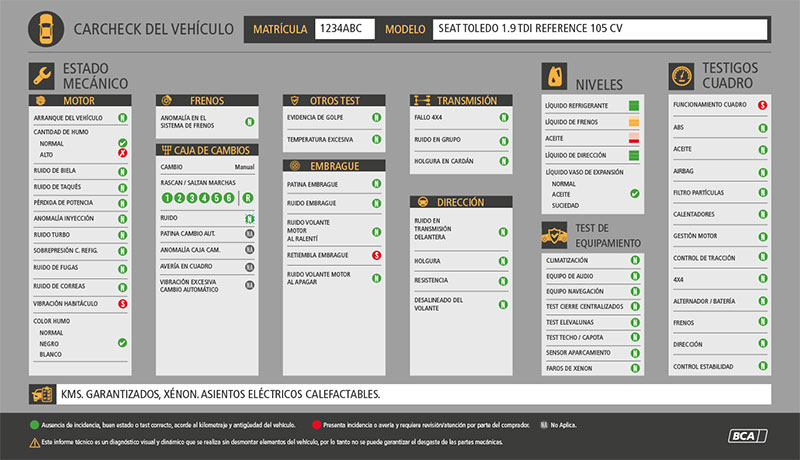
At a glance you can review the report using the colour legend:
|

|
Green: Means no incidents, good condition or correct test, according to the mileage and age of the vehicle.
|
|

|
Red: Indicates that there is an incident or fault and requires revision/attention by the buyer.
|
|

|
Grey: Not applicable, or the vehicle does not have this equipment.
|
Inside the Car Check document you will find the information distributed by sections, as follows:
Vehicle identification
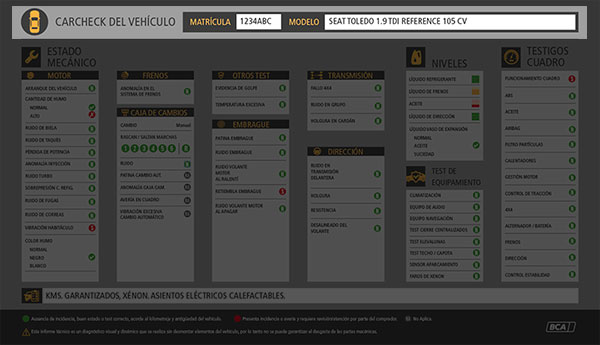
The data shown are: registration number, chassis number, make, number of kilometres, date of registration, colour and model.
Mechanical condition
Motor
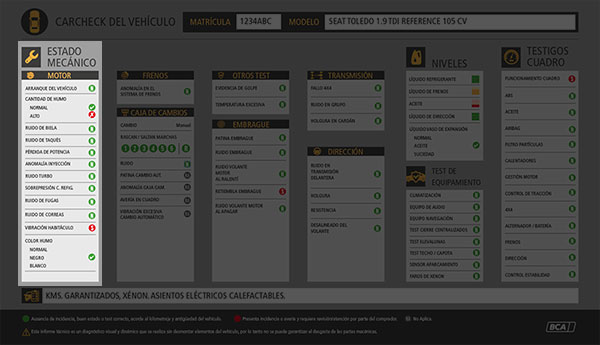
Vehicle starting
|

|
The vehicle starts with the current battery pack or an auxiliary battery.
|
|

|
The vehicle does not start even when using a back-up battery.
|
Smoke quantity
The amount of smoke observed shall be indicated in red if it is excessive, in green if it is normal:
|

|
It is considered normal when the amount of smoke is in accordance with the vehicle's engine speed, and has an unaltered colour and odour when the engine temperature reaches 90º.
|
|

|
It is considered high when it exceeds the normal quantities for use and operation or its odour or colour is abnormal and with the engine temperature at 90º.
|
Smoke color
Only one of the three boxes shall be ticked: normal, black or white.
|

|
Normal: Smoke colour is normal, slightly white.
|
|

|
Black: Smoke is black, with possible traces of soot indicating poor combustion.
|
|

|
White: The smoke is white, with different soft shades of blue and possible traces of water.
|
Rod noise
|

|
Not appreciated.
|
|

|
Loud metallic noise coming from inside the engine and increasing in speed as the vehicle revs (like a "taca, taca, taca...").
|
Tappet noise
|

|
Not appreciated.
|
|

|
Slight metallic noise, like a clanking sound, which intensifies when accelerating.
|
Belt noise
|

|
Not appreciated.
|
|

|
Noise in belts, chain or tensioners in the form of a squeaking noise which usually disappears when hot.
|
Leak noise
|

|
Not appreciated.
|
|

|
Moderate popping noise or cracked sleeves that usually occur in the upper part of the engine.
|
Cabin vibration
|

|
It is either normal, or it has some vibration due to the clutch or flywheel.
|
|

|
Noticeable vibration inside the vehicle, steering wheel or dashboard, with the car started but stationary and caused by studs, silentblock or engine mount.
|
Turbo noise
|

|
Not appreciated.
|
|

|
Noise in the turbine or turbo sleeves, could sound like hissing, whistling or rattling inside.
|
Loses power
|

|
Not appreciated.
|
|

|
The vehicle does not run according to the engine torque or it is difficult to reach the engine speed.
|
Brakes
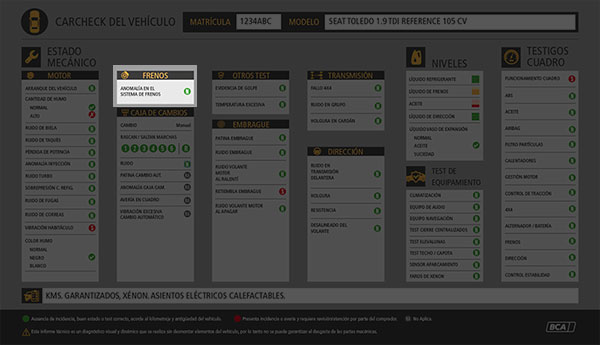
Brakes anomalies
|

|
The vehicle brakes correctly and no anomaly is detected.
|
|

|
We detected an anomaly in the braking system.
|
Gearbox
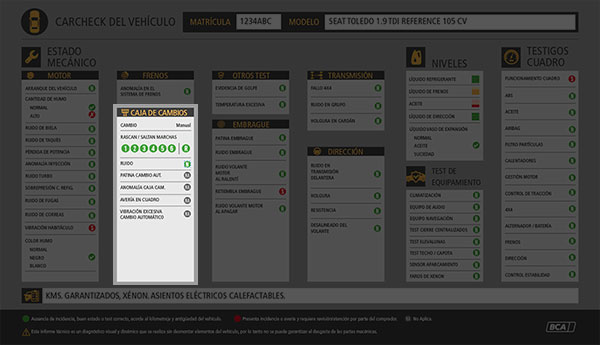
Shift: Auto
|

|
Automatic or semi-automatic gearbox in all variants.
|
Looseness
|

|
Not appreciated.
|
|

|
The gear lever has excessive travel in neutral and slack in all gears.
|
Gears scratch/slip
|

|
The gears behave normally when using the gearbox.
|
|

|
If the clutch is in optimum condition, one or more of the gears do not engage correctly and cause the gearbox to scrape.
|
The gear that scratches/slips will be marked in red and the gear that does not scratch/slip will be marked in green.
 |
No scratches
|
 |
Scratch |
 |
No scratches |
 |
Scratch |
 |
No scratches |
 |
Scratch |
 |
No scratches |
 |
Scratch |
 |
No scratches |
 |
Scratch |
 |
No scratches |
 |
Scratch |
 |
No scratches |
 |
Scratch |
Noise
|

|
Not appreciated.
|
|

|
Noise inside the gearbox, with the vehicle in motion and the gear engaged there is noise inside the gearbox.
|
Automatic shift slips
|

|
The gearbox does not slip.
|
|

|
When any of the speeds are engaged, the vehicle revs up and does not move forward, the acceleration is not proportional to the engine revolutions.
|
Fault in dashboard
|

|
No fault is indicated on the dashboard.
|
|

|
The dashboard indicates a gearbox malfunction.
|
Excessive vibration automatic shift
|

|
Not appreciated.
|
|

|
The automatic transmission exhibits a vibration which is noticeable inside the passenger compartment when the vehicle is in gear and is perceptible on the gear lever.
|
Gearbox anomaly
|

|
No gearbox anomalies are apparent.
|
|

|
The gearbox shows some kind of anomaly different from the previous points, as well as jerks, knocks, noises both when the vehicle is running and at standstill.
|
Steering
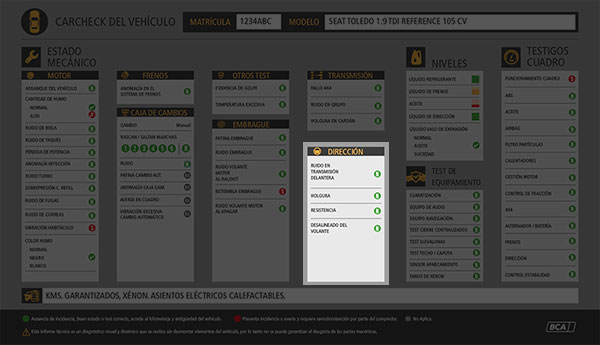
Noise
|

|
There are no unusual noises when turning the steering wheel, with the vehicle started and on a non-slip surface.
|
|

|
The steering has some noise in the steering rack or steering pump when turning the steering wheel, with the vehicle started and on a non-slip surface.
|
Looseness
|

|
No looseness is apparent. The wheels move in proportion to the movement of the steering wheel.
|
|

|
Looseness: When the steering is repeatedly turned to both sides and the vehicle is started, the wheels do not move in proportion to the movement of the steering wheel.
|
Resistance
|

|
Resistance is normal: When the vehicle is started, the steering turns smoothly without noise and with a resistance that corresponds to the type of steering and vehicle.
|
|

|
An anomaly is observed in the steering resistance. It may be an uneven turn, a noise or simply a resistance not in accordance with the type of steering and vehicle.
|
Misalignement
|

|
With the vehicle stationary and the wheels parallel, the steering wheel is completely straight. No anomaly observed.
|
|

|
When the vehicle is stationary and the wheels are parallel, the steering wheel is not aligned.
|
Clutch
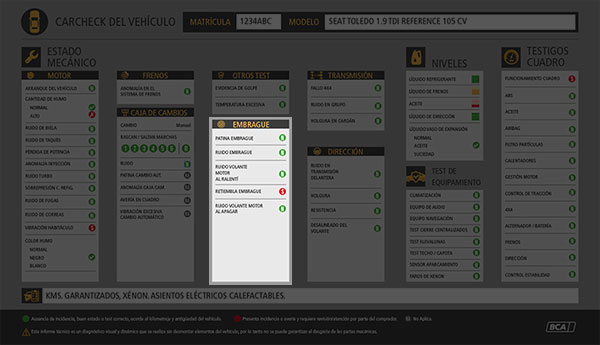
Clutch slips
|

|
Clutch performance is normal.
|
|

|
The acceleration of the vehicle is not proportional to the vehicle and has hardly any force.
|
Clutch shaking
|

|
No clutch shaking is visible.
|
|

|
When the clutch pedal is released, there is a noticeable clutch pedal jerk.
|
Clutch noises
|

|
No noise or resistance when clutching or disengaging.
|
|

|
When clutching or disengaging the clutch there is some noise or resistance.
|
Flywheel noise when idling
|

|
No engine flywheel noise at idling speed.
|
|

|
When the vehicle is started and idling, the flywheel makes a noticeable noise.
|
Flywheel noise switching off
|

|
When the vehicle is stopped, the flywheel does not sound.
|
|

|
When the vehicle is stopped, a loud ratchet-like noise is heard at the steering wheel. This noise is noticeable inside and outside the vehicle.
|
Transmission
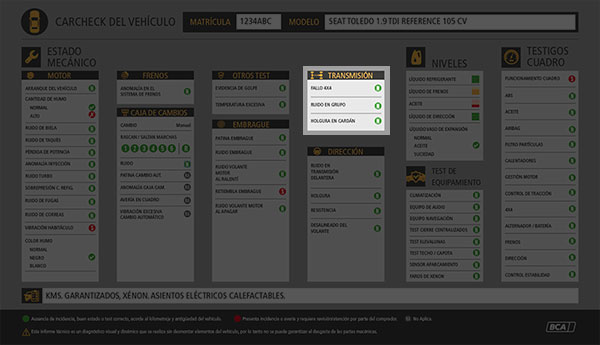
Noise in front transmission
|

|
There are no abnormal noises in the vehicle's transmission.
|
|

|
With the steering wheel turned and the vehicle in motion, noise can be heard in any of its bearings, which may be louder when the vehicle starts or brakes.
|
Fault in 4x4
|

|
The 4x4 transmission behaves normally.
|
|

|
The vehicle does not operate the 4x4 transmission correctly or it shows a fault on the instrument panel.
|
Noise in the assembly
|

|
Not appreciated.
|
|

|
When the vehicle is in motion, the rear transmission distributor sounds and this is aggravated when the vehicle is in motion.
|
Looseness in the drive shaft
|

|
Not appreciated.
|
|

|
Excessive vibration caused by slack in the drive shaft.
|
Other tests
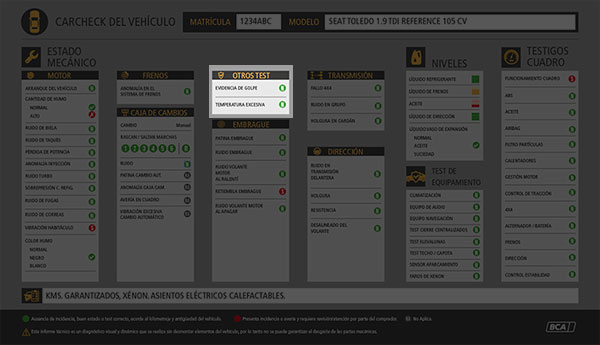
Blow evidence
|

|
There is no evidence of structural impact.
|
|

|
The existence of structural impact is detected.
|
Excessive temperature
|

|
The temperature displayed on the instrument panel temperature display is normal.
|
|

|
The temperature displayed on the instrument panel temperature display is too high.
|
Levels
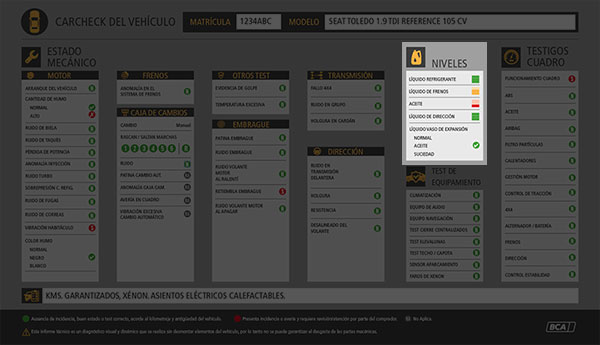
Under levels it shall be checked whether the corresponding liquid level is correct or not. There are two possible values:
|

|
Normal: It is within the limits indicated by the manufacturer.
|
|

|
Low: Not as indicated by the manufacturer.
|
We check the levels of coolant, brake fluid, steering fluid and oil.
For the liquid in the expansion vessel, we mark one of these four fields to indicate what the contents are like:
|

|
Normal: Colour of antifreeze or normal water, without traces of other substances.
|
|

|
Oil: Black oil, coming from the cylinder head or oil cooler.
|

|
Mud: White or brown foam or mayonnaise-like paste on the walls of the expansion vessel or plug.
|

|
Dirt: Traces of leak cap, engine block rust or any other substance that is not antifreeze.
|
Equipment tests
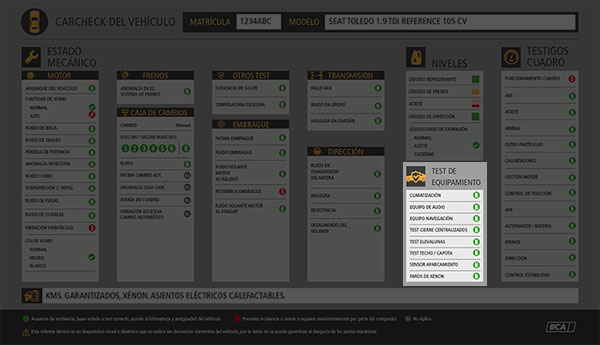
For the liquid in the expansion vessel, we check whether the vehicle has this equipment and whether it functions correctly, depending on the equipment marked at the reception desk. If the vehicle does not have any of the equipment listed, the test is marked NA.
A check of the correct functioning of the vehicle's equipment is carried out, and if we detect that it is not functioning correctly, the test is marked:
AC/Heating
|

|
The air conditioning or climate control system comes into operation and cold air is discharged from the diffusers inside the vehicle.
|
|

|
The air conditioner or climate control unit does not cool or heat properly, either due to a lack of gas charge or a problem with the compressor.
|
Audio equipment (only Radio mode is checked, no CD or AUX mode).
|

|
The audio system emits sound correctly when the radio of the audio system is switched on.
|
|

|
An anomaly is detected in the audio equipment either because it does not work, because of problems in the display or because it does not sound correctly.
|
Navigation equipment
|

|
The navigation equipment switches on correctly and geo-locates the vehicle correctly.
|
|

|
The navigation system is missing a card or disc, or has some kind of problem.
|
Central lock test
|

|
All vehicle doors open and close their latches when the lock button is pressed.
|
|

|
Some or all of the doors have a problem when opening or closing by means of the central locking button.
|
Electric windows
|

|
All electric windows are working properly.
|
|

|
Some of the electric windows have a problem when operated.
|
Roof / hood
|

|
The sunroof or soft top in the case of a convertible opens and closes correctly. The sunblind is not checked in the test.
|
|

|
The sunroof or soft top on convertibles either does not work or opens and closes with some difficulty or has a problem closing.
|
Parking sensor
|

|
The parking sensors function correctly and give a corresponding warning when a nearby object is detected.
|
|

|
One of the sensors does not work or works with an anomaly.
|
Dashboard lights
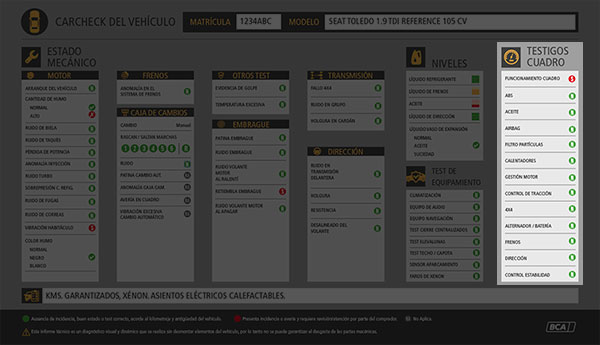
Common for all lights
|

|
The warning light is off.
|
|

|
The warning light is on.
|